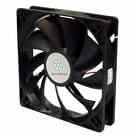
You want to change the fan on your desktop PC or add one, here to compare features to make the right choice.
The fan is an absolutely essential component. While in process, the computer produces lots of heat that can damage the internal components.
Why adding a fan or changing it?
If you want a more powerful fan and/ or less noisy than the original.
If you add a component to your system unit, or replace a component by a more powerful one. A fan will be needed to regulate this new source of heat.
How many fans?
To cool your PC, you must have at least three fans, including the processor. You will need more powerful fans if your computer is overclocked.
Note: If the fan is not strong enough or if there are not enough fans to dissipate the heat produced, the lifetime of components may suffer.
Openings
Your System Unit should contain at least two openings on each side to fully circulate the air stirred by the fans to the outside. The openings shall be preferably in a honeycomb configuration.
Points to consider
Fan Dimensions
Take into account the size of the available space in the system unit, the hardware you need to cooldown and the type of computer. The dimensions are in inches, in this form: 80 x 80 x 25 mm
Fan Type
There are different types of fan for the, processor (CPU), graphics card, VGA, motherboard, chipset, etc..,
Compatibility
The criterion must take into account. The fan must be compatible with the manufacturer (Intel and AMD) processor (Athlon, Duron, Sempron, Turion, Opteron, Celeron, Pentium, Core Duo, ...), socket (receptacle of processors on motherboards) .
Maximum airflow
It is calculated by volume of air moved per minute Cubic Feet per Minute (CF/M). Meaning if figure is more important, the fan is more efficient in terms of cooling. The airflow is usually between 30 and 70 CFM.
Rotational Speed
It is expressed in revolutions per minute: Rotation Per Minute (RPM). The speed is usually between 1200 and 4500 revolutions per minute.
Material
Aluminum and copper are the materials best suited, but you are also fans made of PVC, plastic or performance steel.
Noise Level
The sound level expressed in dBA. The values given by manufacturers vary between 15 and 40 dBA, but they are actually often between 40 and 70dBA. Ensure that noise levels do not exceed 60dBA.











